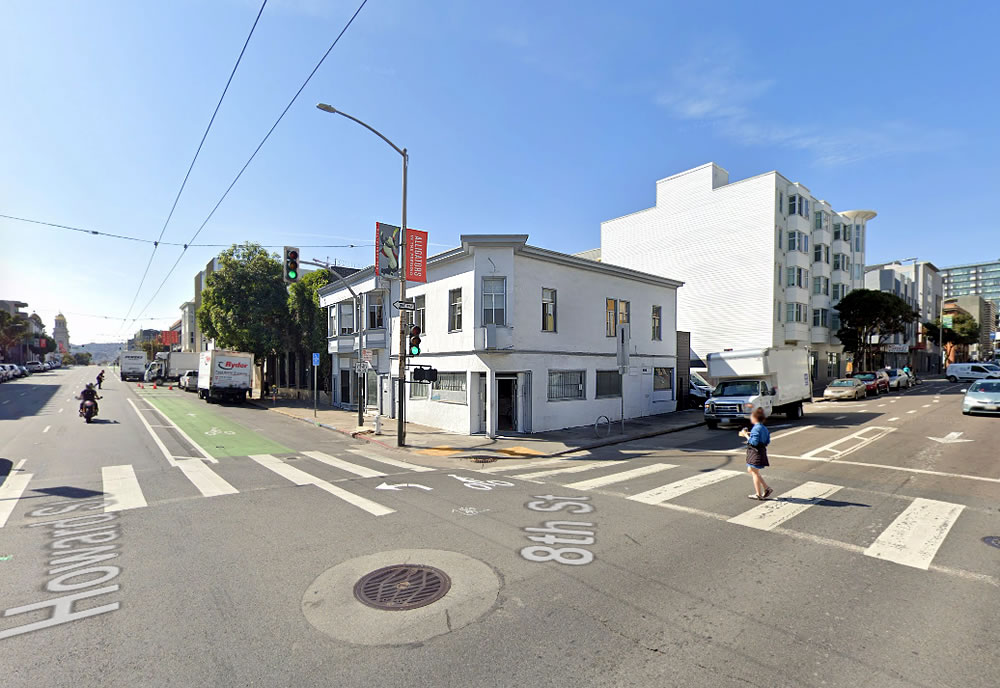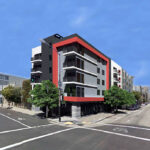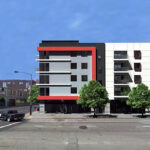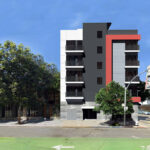Built in 1920, the two-story building on the northwest corner of 8th and Howard might not appear to be particularly noteworthy. But having been identified as a contributing resource to the Western SoMa Light Industrial and Residential Historic District, not to mention having been home to The Black and Blue leather bar back in the 70s, it has been rated as a Class A Historic Resource by the City.
While the aforementioned rating wouldn’t preclude a new five-story development from rising on the site, with 12 apartments over two new ground floor retail spaces as envisioned by Tecta Architecture below, a Historic Resource Evaluation (HRE) will need to be prepared for the project and the design of the proposed development may need to be modified, “to include features and/or memorialization of the cultural meaning” of the resource. Or the resource itself “may need to be partially or fully retained.”
In addition, as the building falls within the boundaries of SoMa Pilipinas, the Filipino Cultural Heritage District, across the street from the Leather and LGBTQ Cultural District, and the existing structures on the site (which extends to 1024 Howard Street) include three existing residential units, the demolition of which is controlled, San Francisco’s Planning Department is recommending the development team engage in a “thorough and sincere public outreach” campaign prior to finalizing their plans, “given the numerous stakeholders and communities” involved.
We’ll keep you posted and plugged-in.




Absolutely ridiculous the hoops you have to jump through to even get something modest built in SF. Nothing notable about this “historic resource” whatsoever. A plaque describing the history of the site should suffice…..
Agreed. This a major reason is why SF housing is so expensive. Imagine how many smaller scale projects could’ve been constructed over previous decades if SF Planning didn’t enact these obstructionist requirements which massively deter investment in building homes across the City.
SF Planning essentially inviting “community organizations” to extort home builders on this & other projects.
The HRE requirements and designations are actually based on California’s Environmental Quality Act (CEQA), guidelines and definitions, they’re not San Francisco specific policies.
But the proliferation of “cultural districts” is a San Francisco phenomenon & requirement right? Does CEQA set objective standards for cities to establish “historic districts”? It seems like SF has created a ton of those to prevent new development.
The cultural districts are largely created to extract “benefits” from builders. Most of them say it on their websites. Does CEQA require cultural districts?
It seems like there are some CEQA requirements, but SF efforts make them far more onerous to new construction than the state law requires.
Yet another example of what CEQA — which was originally intended for only public projects — has morphed into; its become an notorious grab bag of regulatory over-reach and an weapon of extortion by project opponents.
It’s 5-decades of existence exactly correspond to the decline of housing production and attendant rise in housing prices far beyond the COL in California. In order to provide housing reform, CEQA, likewise, needs massive reform (not just a nibbling around the edges).
“This a major reason is why SF housing is so expensive.”
Nah, the main reasons for the high cost of housing in SF are ZIRP and QE Infinity propping up historic hockey stick asset bubbles, the historic shift from a productive economy to a FIRE economy, historic foreign capital flight/money laundering, historic stock buybacks (including redundant software companies that will never turn a profit), AirBnB removing historic units from the housing market, historically long commutes for construction workers, RE functioning as a historic de facto cartel instead of an open market, historically asymmetric information and “sticky” prices, and hysterically great burritos.
Go build in Pleasanton. No roadblocks there.
I recall an article in the San Francisco Chronicle from 10 or more years ago discussing the even more restrictive historic resource rules for development in Berkeley. The examples given were vacant lots (not People’s Park, but just random vacant lots on side streets) where nothing could be built because of a grainy old photo of a building that had stood on the site long ago.
Historic asset notwithstanding, this design is atrocious! Really ugly.
They should paint it black and blue!
AGREE! This is Hideous (with a capital ‘H’). Having to incorporate the exisiting facade might actually help make better.
The Western SOMA Plan is going to prevent all sorts of development in the coming decades.
Let’s hope so, but the banker-builder-landlord-used house salesman mob usually gets its way, because politicians and administrators are so easy to buy off for so little.
Thank God.
the western SOMA plan is the foremost piece of BS plan ever created. it was if they were planning for the 90s instead of the future. it needs to be fully revamped. Western SOMA is central, close to many transit options, very walkable and next to new central SOMA business district. there should be 8-12 story residential all across western soma
I’ve flipped and gone full cynic. As a property owner, the Western SOMA plan delights me. Filling the area with 10-12 story residential buildings would create tens of thousands of new housing units. An increase in supply of this magnitude would have a significant negative impact on existing property values. Limiting supply will be great for my kids. Their rental units will support them their entire lives. Long live restrictive zoning!
Refreshing when a NIMBY is upfront about their opposition. The state should take away as much local land-use control as it can.
I spent years arguing and voting in favor of building new housing. At some point, though, I gave up fighting the progressive on this. If they are so insistent on boosting the market value of my property, why should I fight them? My children will appreciate their efforts.
Wait until you hear about the zoning on the entire west side of the city.
I know all about it. Let me tell you, on behalf of existing property owners, it’s fantastic!
The proposed new building is already an homage to sadomasochism. No need for any further recognition of the prior occupant.